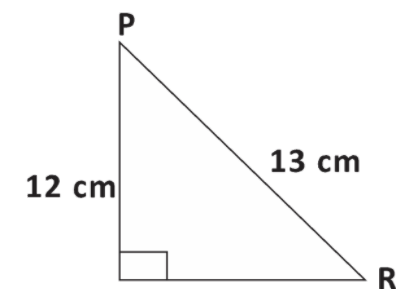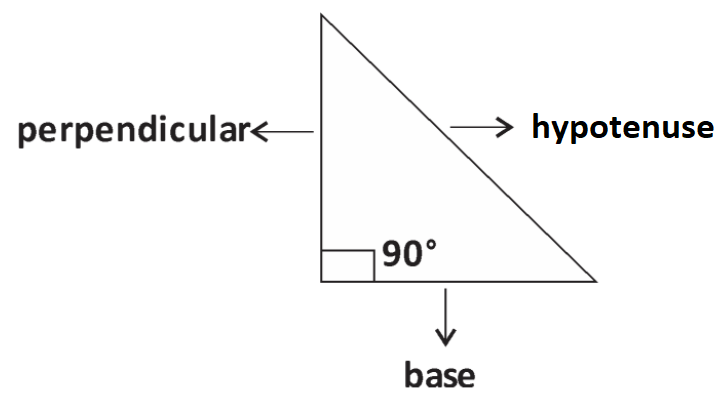
In the figure above, find tan \[p{\text{ }}-\]cot R.

(A) 5
(B) \[\dfrac{1}{{13}}\]
(C) 0
(D) none of these

Answer
571.2k+ views
Hint: To solve this question, we must have an idea about Pythagoras theorem for right-angled triangles.
Here the above picture is a right-angled triangle.
The sides of right-angled triangle named as base, perpendicular, and hypotenuse \[\left[ {longest{\text{ }}side} \right]\] The angle of opposite side of hypotenuse is \[90^\circ .\]

According to Pythagoras theorem,
\[{\left( {hypotenuse} \right)^2} = {\text{ }}{\left( {Perpendicular} \right)^2} + {\text{ }}{\left( {Base} \right)^2}\]
\[ \Rightarrow \]hypotenuse \[ = \sqrt {{{\left( {perpendicular} \right)}^2} + {{\left( {Base} \right)}^2}} \]
\[ \Rightarrow \] we know that it \[\theta \] is the angle of a right-angled triangle,
Then, \[\tan \theta = \dfrac{{perpendicular}}{{base}}\]
\[\cot \theta = \dfrac{1}{{\tan \theta }} = \dfrac{{base}}{{perpendicular}}\]
Complete step by step answer:

Given that
\[PQ{\text{ }} = {\text{ }}12{\text{ }}cm\]
\[PR{\text{ }} = {\text{ }}13{\text{ }}cm\]
\[\angle PQR = 90^\circ \]
At first, we have to find out \[QR\], the base of \[\Delta PQR\]
Here, \[PQ{\text{ }} = \] perpendicular to the triangle.
\[QR{\text{ }} = \] base of the triangle.
\[PR{\text{ }} = \] hypotenuse of the triangle.
By Pythagoras theorem,
\[ \Rightarrow {\left( {hypotenuse} \right)^2} = {\text{ }}{\left( {perpendicular} \right)^2} + {\text{ }}{\left( {Base} \right)^2}\]
\[ \Rightarrow \left( {P{R^2}} \right) = {\left( {PQ} \right)^2} + {\left( {QR} \right)^2}\]
\[ \Rightarrow {\left( {QR} \right)^2} = {\left( {PR} \right)^2} - {\left( {PQ} \right)^2}\]
\[ \Rightarrow QR = \sqrt {{{\left( {PR} \right)}^2} - {{\left( {PQ} \right)}^2}} \]
\[ = \sqrt {{{\left( {13} \right)}^2} - {{\left( {12} \right)}^2}} \] \[[{\text{ }}since,\;PR{\text{ }} = {\text{ }}13{\text{ }}cm\]
\[ \Rightarrow PQ{\text{ }} = {\text{ }}12{\text{ }}cm]\]
\[ = \sqrt {169 - 144} \]
\[ = \sqrt {25} = 5\]
\[\therefore \] base \[QR{\text{ }} = {\text{ }}5{\text{ }}cm.\]
Now, we calculate the value of tan p & cot R.
\[ \Rightarrow \tan P = \dfrac{{perpendicular}}{{Base}}\]
\[ = \dfrac{{QR}}{{PQ}} = \dfrac{5}{{12}}\]
[for angle P, the opposite side of angle is perpendicular \[\left( {QR} \right).\]Base is \[PQ\]. Opposite side of right angle is hypotenuse]
\[\cot R = \dfrac{{Base}}{{perpendicular}}\]
\[ = \dfrac{{QR}}{{PQ}} = \dfrac{5}{{12}}\] [for here angle R, the of angle opposite sides is perpendicular \[\left( {PR} \right)\] base is \[QR]\]
\[\therefore \,\,\tan \,P - \cot R = \dfrac{5}{{12}} - \dfrac{5}{{12}} = 0\]
\[\therefore \] option (c) is right.
Note: A right-angled triangle’s base is one of the sides that adjoins the 90-degree angle.
- The three main functions in trigonometry are sine, cosine, and tangent. It \[\theta \] is the angle of right-angled triangle then
\[ \Rightarrow \sin \theta = \dfrac{{perpendicular}}{{hypotenuse}},\cos \theta = \dfrac{{base}}{{hypotenuse}}\] when we solve this type of question, we need to remember all the formulas of trigonometry.
Here the above picture is a right-angled triangle.
The sides of right-angled triangle named as base, perpendicular, and hypotenuse \[\left[ {longest{\text{ }}side} \right]\] The angle of opposite side of hypotenuse is \[90^\circ .\]

According to Pythagoras theorem,
\[{\left( {hypotenuse} \right)^2} = {\text{ }}{\left( {Perpendicular} \right)^2} + {\text{ }}{\left( {Base} \right)^2}\]
\[ \Rightarrow \]hypotenuse \[ = \sqrt {{{\left( {perpendicular} \right)}^2} + {{\left( {Base} \right)}^2}} \]
\[ \Rightarrow \] we know that it \[\theta \] is the angle of a right-angled triangle,
Then, \[\tan \theta = \dfrac{{perpendicular}}{{base}}\]
\[\cot \theta = \dfrac{1}{{\tan \theta }} = \dfrac{{base}}{{perpendicular}}\]
Complete step by step answer:

Given that
\[PQ{\text{ }} = {\text{ }}12{\text{ }}cm\]
\[PR{\text{ }} = {\text{ }}13{\text{ }}cm\]
\[\angle PQR = 90^\circ \]
At first, we have to find out \[QR\], the base of \[\Delta PQR\]
Here, \[PQ{\text{ }} = \] perpendicular to the triangle.
\[QR{\text{ }} = \] base of the triangle.
\[PR{\text{ }} = \] hypotenuse of the triangle.
By Pythagoras theorem,
\[ \Rightarrow {\left( {hypotenuse} \right)^2} = {\text{ }}{\left( {perpendicular} \right)^2} + {\text{ }}{\left( {Base} \right)^2}\]
\[ \Rightarrow \left( {P{R^2}} \right) = {\left( {PQ} \right)^2} + {\left( {QR} \right)^2}\]
\[ \Rightarrow {\left( {QR} \right)^2} = {\left( {PR} \right)^2} - {\left( {PQ} \right)^2}\]
\[ \Rightarrow QR = \sqrt {{{\left( {PR} \right)}^2} - {{\left( {PQ} \right)}^2}} \]
\[ = \sqrt {{{\left( {13} \right)}^2} - {{\left( {12} \right)}^2}} \] \[[{\text{ }}since,\;PR{\text{ }} = {\text{ }}13{\text{ }}cm\]
\[ \Rightarrow PQ{\text{ }} = {\text{ }}12{\text{ }}cm]\]
\[ = \sqrt {169 - 144} \]
\[ = \sqrt {25} = 5\]
\[\therefore \] base \[QR{\text{ }} = {\text{ }}5{\text{ }}cm.\]
Now, we calculate the value of tan p & cot R.
\[ \Rightarrow \tan P = \dfrac{{perpendicular}}{{Base}}\]
\[ = \dfrac{{QR}}{{PQ}} = \dfrac{5}{{12}}\]
[for angle P, the opposite side of angle is perpendicular \[\left( {QR} \right).\]Base is \[PQ\]. Opposite side of right angle is hypotenuse]
\[\cot R = \dfrac{{Base}}{{perpendicular}}\]
\[ = \dfrac{{QR}}{{PQ}} = \dfrac{5}{{12}}\] [for here angle R, the of angle opposite sides is perpendicular \[\left( {PR} \right)\] base is \[QR]\]
\[\therefore \,\,\tan \,P - \cot R = \dfrac{5}{{12}} - \dfrac{5}{{12}} = 0\]
\[\therefore \] option (c) is right.
Note: A right-angled triangle’s base is one of the sides that adjoins the 90-degree angle.
- The three main functions in trigonometry are sine, cosine, and tangent. It \[\theta \] is the angle of right-angled triangle then
\[ \Rightarrow \sin \theta = \dfrac{{perpendicular}}{{hypotenuse}},\cos \theta = \dfrac{{base}}{{hypotenuse}}\] when we solve this type of question, we need to remember all the formulas of trigonometry.
Recently Updated Pages
Two men on either side of the cliff 90m height observe class 10 maths CBSE

What happens to glucose which enters nephron along class 10 biology CBSE

Cutting of the Chinese melon means A The business and class 10 social science CBSE

Write a dialogue with at least ten utterances between class 10 english CBSE

Show an aquatic food chain using the following organisms class 10 biology CBSE

A circle is inscribed in an equilateral triangle and class 10 maths CBSE

Trending doubts
The shortest day of the year in India

Why is there a time difference of about 5 hours between class 10 social science CBSE

Write a letter to the principal requesting him to grant class 10 english CBSE

What is the median of the first 10 natural numbers class 10 maths CBSE

The Equation xxx + 2 is Satisfied when x is Equal to Class 10 Maths

What is the missing number in the sequence 259142027 class 10 maths CBSE




